- Exclusive
- National
- Victoria
- Supermarkets
This was published 6 months ago
Robots have been taught to help pack groceries. But they’ll never do this
It takes just five minutes for this warehouse to put together a 50-item supermarket order.
With 700 robots, artificial intelligence and 1000 employees, Coles’ new 24-hour customer fulfilment centre in western Melbourne is busier and higher-tech than your average supermarket.
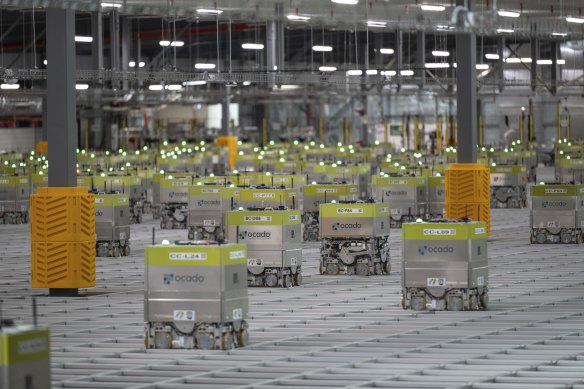
“The hive” at the Coles customer fulfilment centre, where robots collect products at great speed.Credit: Penny Stephens
Coles spent $400 million building automated customer fulfilment centres in Melbourne and Sydney after COVID sped up digital sales. Before 2020, fewer than 4 per cent of Coles supermarket sales were online; now, close to 11 per cent of weekly, top-up and last-minute grocery orders are digital.
Not long ago, online orders for Coles deliveries in Melbourne were assembled by local stores. Now, every next-day online delivery order for greater Melbourne is assembled and dispatched from this warehouse, which can send out 10,000 orders a day. Coles said the new customer fulfilment centres produced orders that were more accurate and more likely to be delivered on time, and reduced congestion in local stores.
Regional online orders and click-and-collect are still done through local stores.
At the Truganina warehouse, products arrive from nearby distribution centres and are transported by robots upstairs to “the hive”, an enormous 3D grid-like system that stores items based on their popularity. The most popular items are bananas, Coles three-litre full cream milk, mandarins, strawberries and tomatoes.
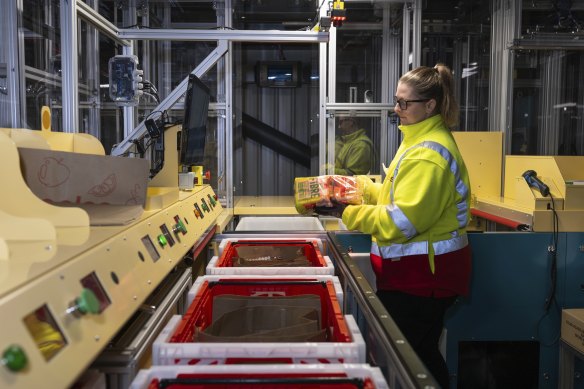
Retail team member Krystal Price at a picking station in the Coles customer fulfilment centre. Credit: Penny Stephens
The hive is like the aisles of a supermarket, but instead of shoppers pulling products off the shelves, robots pick ordered items at speed and whizz them through the grid via chutes to a picking station below.
The picking stations have machines that tell staff which products go in which bags.
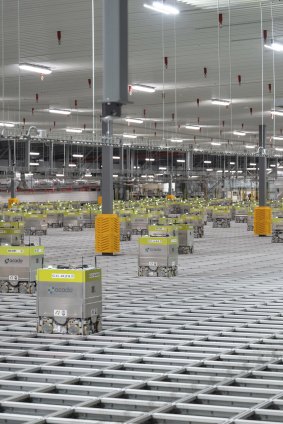
Robots at work in Truganina.Credit: Penny Stephen
Nathan Wallace, general manager of Coles customer fulfilment centre operations, said sophisticated “cubing logic” guides the packing. “There’s logic around what bruises and what can taint, so you won’t put bleach with apples. Equally, you won’t put a loaf of bread down the bottom. All that logic is built into it,” he said.
Once a customer’s order is assembled, it is brought together and placed in a truck. Delivery trucks also use AI software – rather than Google Maps – to determine the most efficient routes. The software is sensitive enough to allow extra time for apartments and new addresses.
Coles’ Truganina warehouse also has a shop where staff can buy discounted food close to its use-by date. Food that cannot be sold is also given to the staff canteen, which sells $3 coffees and $5 meals, or donated to food relief charities Foodbank and SecondBite.
Phil Stephens of Ocado, Coles’ UK technology partner, said Australia was one of the fastest-growing markets in the world for grocery e-commerce.
Woolworths has 49.4 per cent of the Australian online grocery market and Coles holds 30.7 per cent, according to the latest IBISWorld figures.
German supermarket Aldi does not offer online shopping because online sales are less profitable than instore ones.
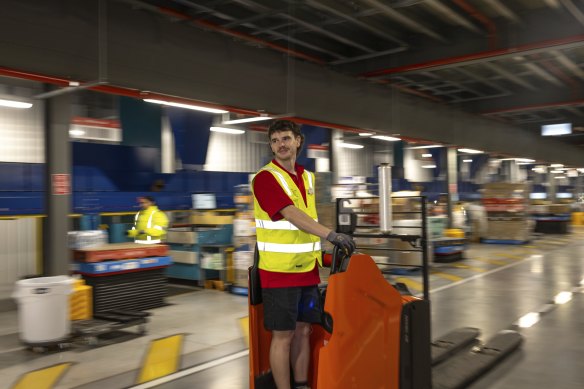
The fulfilment centre dispatches next-day online delivery orders around Melbourne.Credit: Penny Stephens
Woolworths said 14.5 per cent of its sales last quarter were online, up from 12.2 per cent a year ago. It said it was making significant investments in its e-commerce network, which included seven customer fulfilment centres where workers “handpick thousands of online orders to the highest standard every day”.
Retail expert Trent Rigby said Woolworths was considered more advanced for online grocery orders. He said the industry was waiting to see whether US giant Amazon got into fresh food.
“Amazon do staples here in Australia, things like sauce and nappies, but where they don’t play is fresh food, so it will be interesting to see what Amazon does. They would almost certainly need to acquire someone to have a distribution network for fresh food.”
The Australian Retailers Association said online sales were growing at 6.4 per cent a year, and that automation and AI would play a crucial role for retailers in coming years.
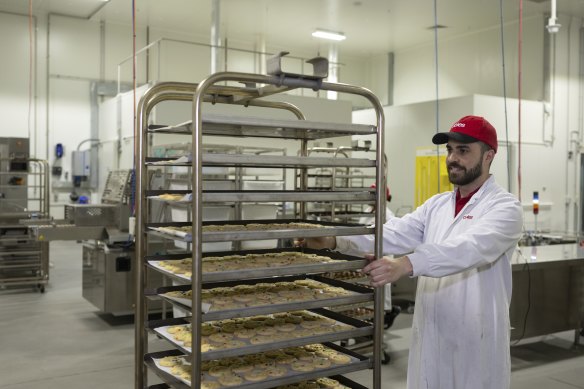
The in-house bakery at the Coles centre.Credit: Penny Stephens
“Through the use of innovations like robots and AI, manually laborious jobs can be taken over by technology, leaving room for employees to re-skill or work in other more fulfilling roles, such as operating hi-tech parking equipment, logistics or customer-facing positions,” the association’s Fleur Brown said.
But harsh warehouse conditions in the US have thrown the spotlight on conditions in Australia. Michael Donovan, Victorian secretary of the SDA union, which represents retail and warehouse workers, said new technology was affecting the way people worked everywhere, including at the Coles customer fulfilment centre in Truganina.
“The SDA has negotiated wages and conditions for workers at this site. We are in constant contact with our members to ensure they are satisfied with their working arrangements.”
The online investments come as Coles and Woolworths face legal action from the competition watchdog, which alleges that the supermarket giants manipulated prices on hundreds of everyday staples to boost their bottom lines.
Start the day with a summary of the day’s most important and interesting stories, analysis and insights. Sign up for our Morning Edition newsletter.